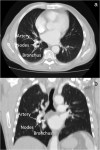Handling benign interlobar lymphadenopathy during thoracoscopic lobectomy
- PMID: 33811459
- PMCID: PMC8088934
- DOI: 10.1111/1759-7714.13949
Handling benign interlobar lymphadenopathy during thoracoscopic lobectomy
Abstract
The presence of calcified or inflammatory lymph nodes between the target bronchus and pulmonary artery is a huge challenge when performing thoracoscopic lobectomy as it may frequently result in tearing of the vessel, and massive bleeding. Herein, we describe a simple strategy in which thoracoscopic lobectomy was safely completed in similar cases. After fissure dissection, the target pulmonary artery was exposed by more than two-thirds of its circumference. A needle was passed across the nodes and the target vessel was closed with a proximal and distal suture. After dissection of lymphadenopathies, the target bronchus was exposed, and stapled. This strategy was applied with success to complete right lower lobectomies for cancer in three patients. No complications occurred during the operation. Only one patient had persistent air leaks that spontaneously ceased 11 days later. Final pathology showed pN0 disease in all cases.
Keywords: lobectomy; lymphadenopathy; thoracoscopy.
© 2021 The Authors. Thoracic Cancer published by China Lung Oncology Group and John Wiley & Sons Australia, Ltd.
Conflict of interest statement
The authors disclose no conflict of interest.
Figures


References
-
- Gazala S, Hunt I, Valji A, Stewart K, Bedard E. A method of assessing reasons for conversion during video‐assisted thoracoscopic lobectomy. Interact Cardiovasc Thorac Surg. 2011;12:962–4. - PubMed
-
- Park JS, Kim HK, Choi YS, Kim J, Shim YM, Kim K. Unplanned conversion to thoracotomy during video‐assisted thoracic surgery lobectomy does not compromise the surgical outcome. World J Surg. 2011;35:590–5. - PubMed
-
- Samson P, Guitron J, Reed MF, Hanseman DJ, Starnes SL. Predictors of conversion to thoracotomy for video‐assisted thoracoscopic lobectomy: A retrospective analysis and the influence of computed tomography‐based calcification assessment. J Thorac Cardiovasc Surg. 2013;145(6):1512–8. - PubMed
-
- Kamiyoshihara M, Nagashima T, Ibe T, Takeyoshi I. A tip for controlling the main pulmonary artery during video‐assisted thoracic major pulmonary resection: The outside‐field vascular clamping technique. Interact Cardiovasc Thorac Surg. 2010;11:693–5. - PubMed
Publication types
MeSH terms
LinkOut - more resources
Full Text Sources
Other Literature Sources
Medical

